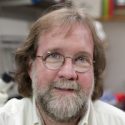Award allows UW biochemist to investigate mitochondria mystery
Every student of basic biology learns that mitochondria are the powerhouses of the cell — little factories turning oxygen and food into energy.
But when it comes to mitochondria, it’s really just the basics that are clear, according to Dave Pagliarini, a University of Wisconsin–Madison biochemist.
“They have are hundreds of parts with unknown functions,” Pagliarini says. “But we do know that when there are genetic problems that cause malfunctions in those parts, the result is often disease.”
With the support of a prestigious Searle Scholar Award, Pagliarini hopes to pull at the strings tying those parts together to determine their role in mitochondria and how they give rise to illness.
The selection process for a $300,000 Searle award prizes forward-thinking, aggressive science — often a luxury for early-career investigators.
“The Searle Scholars program empowers young scientists to try out their best ideas,” says Pagliarini, who was one of 15 national honorees this year. “They encourage you to be assertive and innovative, which typically is not feasible when you’re just starting out.”
Just two years into his career at UW–Madison, Pagliarini’s lab is focused on the role of mitochondrial dysfunction in common disorders such as Type II diabetes and certain cancers, as well as the way “broken parts” lead to a group of genetic disorders known as inborn errors of metabolism.
“The problems are very diverse clinically, from neonatal fatalities to mild chronic diseases,” Pagliarini says. “The effects are often strong in energy-hungry tissues like muscles and the brain. But problems with specific proteins can damage very specific tissues, like the retina or the intestines.”
Human beings are about 10 percent mitochondria by weight, and — as Pagliarini found during postdoctoral research at Harvard Medical School — the ubiquitous organelles are home to between 1,200 and 1,400 distinct proteins. As many as 100 of those protein molecules are directly involved in shuttling protons and electrons around to turn oxygen and your breakfast into adenosine triphosphate — ATP, used as a source of energy around the body.
Pagliarini’s Searle-backed research tack is an exploration of a particular protein from a group of enzymes called kinases. This mitochondrial kinase, ADCK3, helps to produce a key molecule that is essential for fueling the ATP assembly line.
“When this kinase breaks down, you stop production of a particular metabolite, and when you lose that metabolite, you shut down the engine that drives energy production,” Pagliarini says.
In a complicated chain full of vital links, it’s ADCK3’s long history of service that makes it stand out.
“This kinase has been kept around through billions of years of evolution in all sorts of organisms without changing much,” Pagliarini says. “Conservation like that screams importance.”
If only the other 1,200 or so proteins at work in mitochondria came with similar clues to their importance. To make a dent in that long list, Pagliarini and John Markley, UW–Madison Steenbock Professor of Biomolecular Structure, formed the National Institutes of Health-Funded Mitochondrial Protein Partnership. They hope to characterize the molecules that play mysterious roles in such a wide range of illnesses.
“UW-Madison biochemistry has a rich history in metabolism and bioenergetics, in understanding how living things make and use energy,” Pagliarini says. “And we’ve drawn about 30 collaborators from around the world to work in this partnership.”
The university also has a long history with the Searle Scholars program, which was established by John G. (once president of Metamucil- and Dramamine-producing G.D. Searle & Co.) and Frances C. Searle in 1980 to support research in medicine, chemistry and biological science.
Four of Pagliarini’s colleagues in biochemistry — most recently Douglas Weibel, in 2008 — have received the honor. In all, eight UW–Madison scientists have been named Searle scholars since 1987.
Tags: biosciences, faculty awards, research



